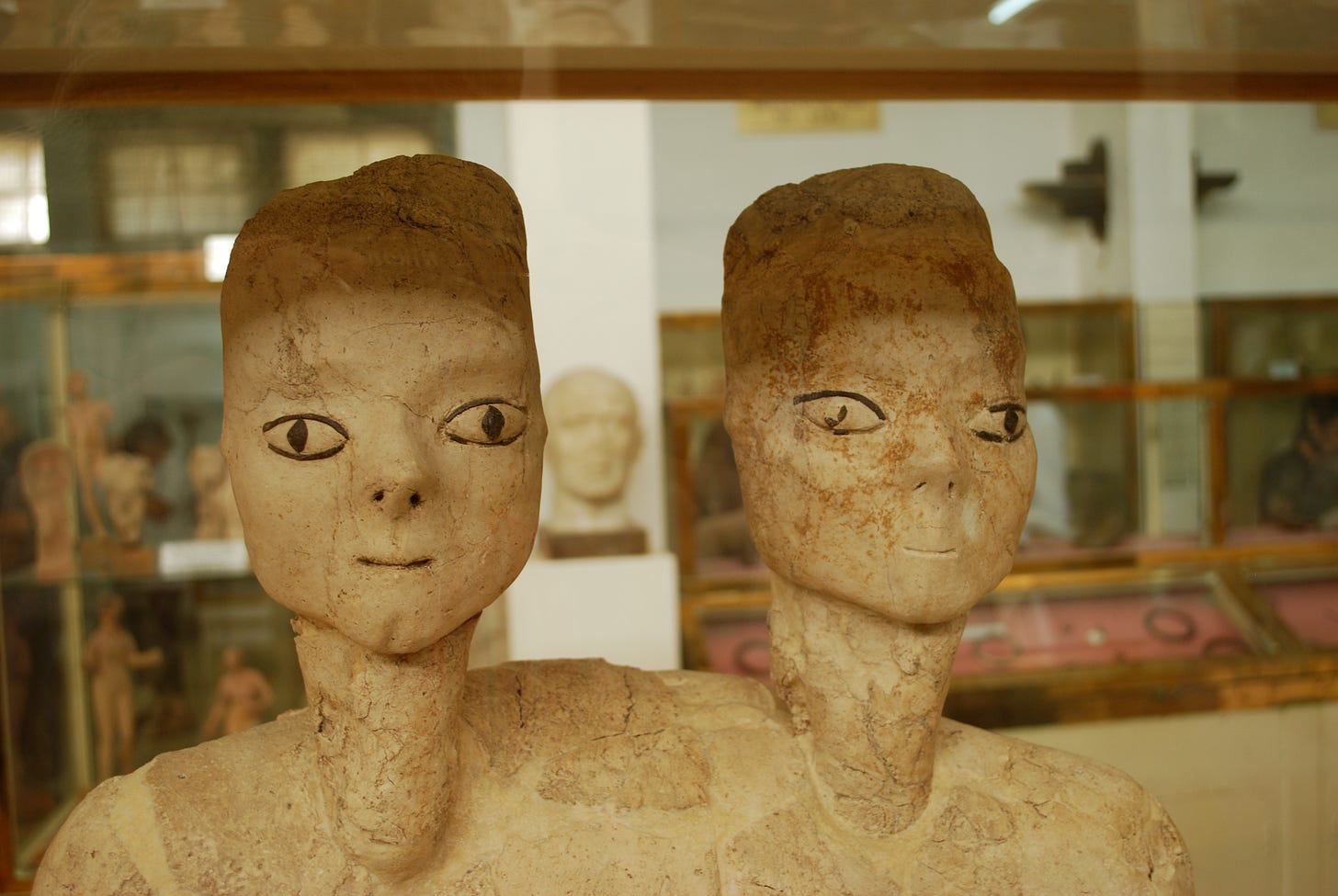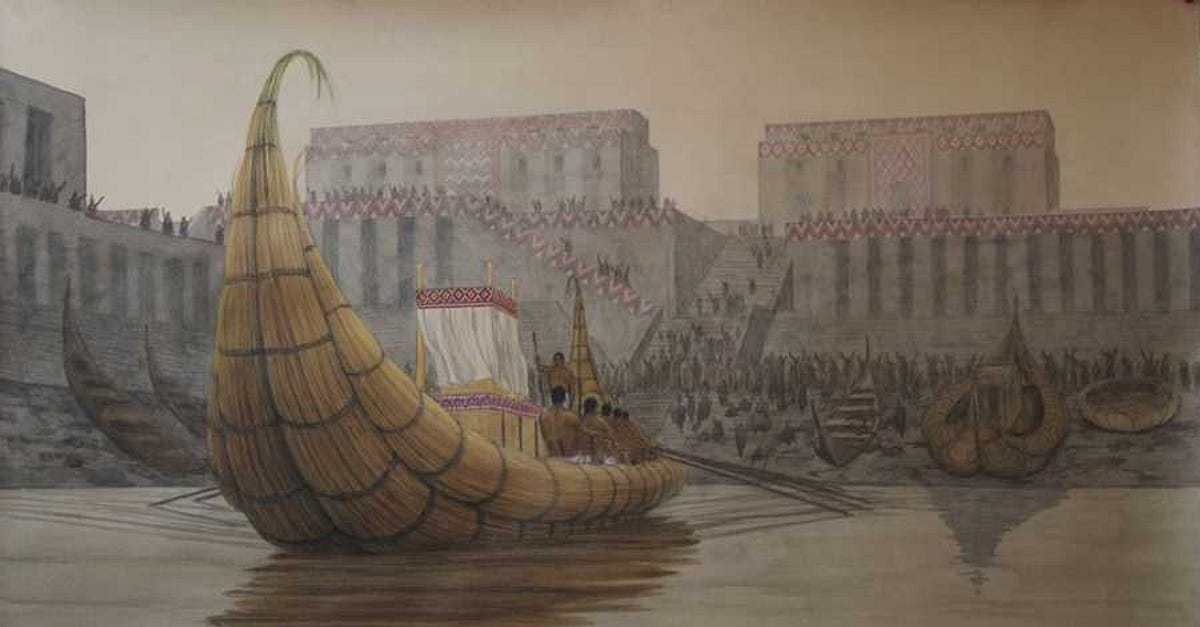Mesopotamia and the Dawn of History
Rivers, marshes, and the first cities
If you were a hunter-gatherer living around 10,000 years ago - after the ice sheets had receded, temperatures rose, and sea levels started to rise - there weren’t many better places on the planet to be living than the Fertile Crescent of the Near East. It’s a nice slice of land, heading north from what’s now Israel through Jordan and Syria into southern Turkey, turning east through northern Iraq, and then south along the fringes of Iran’s Zagros Mountains.
The Fertile Crescent was just that, fertile. There were abundant herds of gazelle to hunt and huge stands of wild grasses covering the valleys and hillsides. The grasses weren’t the easiest food source to process, requiring hard work with mortar and pestle or grinding stone to make flour, but wild wheat and barley were abundant and easy to harvest. In time, these foragers learned to intentionally cultivate the grasses, planting fields and tending them near their permanent home villages. Domesticated animals like sheep, goats, and cattle soon joined the grasses and the people, and the farming lifestyle was born. Soon, an agricultural revolution would sweep across the planet, forever altering how people could live and leading directly to the future heights of cities, states, and civilization.
That’s one way of looking at it, as a step on the way to the world we know and cherish. Another, to borrow a term from the political scientist James C. Scott, is to call this motley collection of people, plants, and animals the residents of the “Neolithic Multispecies Resettlement Camp.” The camp wasn’t a happy place; instead, it was a crowded, dirty, disease-ridden deathtrap where bacteria and viruses jumped from host to host and wiped out entire societies comprised of poorly nourished, unhealthy farmers living at the edge of subsistence.
Six of one, half a dozen of another, as they say.
It took thousands of years for the farming way of life to firmly take root in the Fertile Crescent, and for full-blown agricultural societies to develop and spread throughout the region. Pottery, village life, irrigation, and figural art were only a few of their inventions during this long period of time; cities, writing, and states would soon follow.
But those things - the core of what we might consider “civilization” - didn’t actually appear in the Fertile Crescent proper, where the cultivated grasses grew under the steady and predictable rainfall and domesticated animals had plenty of forage. Instead, they showed up some way to the south of that pleasant zone.
Southern Iraq isn’t an obvious setting for the emergence of the technologies and institutions that form the bedrock of our world. It’s mostly desert, which doesn’t seem especially conducive to the growth of large-scale settlements or complex political structures. That might be the case, if not for the fact that two major rivers flow through the desert on their way to the sea. The Tigris and the Euphrates create thin but productive ribbons of green amid the dry plains, and when they flood, they leave behind mile after mile of fertile silt. If it can be irrigated, as it was by the time cities, writing and the state showed up, this is some of the best farmland in the world.
For a long time, scholars assumed that this fact - the potential fertility of the southern Mesopotamian floodplain - was the cornerstone of civilization as we understand it. According to this line of reasoning, civilization was essentially a hydraulic invention: States, cities, and everything else emerged together with irrigation in a mutually reinforcing feedback loop. Irrigation allowed for population growth, which created cities and political hierarchies, which could then mobilize and organize large amounts of human labor for still-larger irrigation projects, and so on until boom, you pass some threshold and you’ve got civilization. It’s logical enough, and it accounts for the fact that all of these things do seem to appear together.
It’s wrong, though. The kind of irrigation we see in Mesopotamia before and around the emergence of cities and the state - roughly 3800 BC - is small in scale. A single village’s worth of farmers could have easily cut and maintained the canals that show up in the archaeological record. They could be a few miles long, so they’re not exactly tiny, but they’re a lot easier to dig out than you might think. That’s because the Tigris and and especially the Euphrates are slow-moving and full of silt, which piles up into raised banks as they head south. If you’re cutting an irrigation canal perpendicular to the raised banks, the water flows downhill.
That’s a much easier engineering problem to solve than having to calculate and implement a subtle grade over miles of distance. People did eventually dig canals like this in southern Mesopotamia, sometimes spanning dozens of miles in length and running parallel to the great rivers, but not until much later. Huge state-driven irrigation projects didn’t make the desert bloom and create civilization along the way.
The reality is rather less predictable. The first cities in southern Mesopotamia emerged not in the heart of the floodplain, but at the edges of the great marshes where the Tigris and Euphrates slowly seeped into the Persian Gulf. Between 5,000 and 7,000 years ago, the Persian Gulf extended much further north than it does today, as far as 150 miles further inland.
It’s a bit misleading to say this, though, since much of that 150 miles was less open water than a constantly shifting wetland. Fresh water from the rivers runs into the salt water of the sea, a line that moves back and forth with the tides. Reeds and grasses grow in abundance. Small hillocks of raised land called “turtlebacks” occasionally rise up from the shallow waters.
We’re conditioned to think of marsh as relatively unproductive, but that’s not the case. For the people of southern Mesopotamia around 5,000 BC, the marshes were the richest spot in the landscape. They were full of fish, waterfowl, and edible plants. The reeds that grew in abundance could be used for boats, houses, and a variety of other purposes. Practically every one of those turtlebacks was home to a village, often quite densely populated ones.
North of the marshes, along the rivers, farming villages had grown in size and number. Like the marsh-dwellers, the farmers had adapted their own distinctive and clever way of life. Along the banks of the rivers, where water was most plentiful, the villagers planted orchards of palms and intensively cultivated small, productive gardens. Their irrigation canals, up to several miles in length, fed fields of grain. Beyond that, in the drier lands, they grazed herds of sheep and goats. The marshes were close, and they could always take their boats to the nearest patch of wetland to fish or trade their agricultural produce or pottery with the marsh-dwellers.
Here, where the marsh-dwellers met the farmers, was where the earliest cities emerged. This was literally true in the case of Eridu, which the later people of Mesopotamia considered to be the first city and the home of their gods and key institutions: It was situated on the edge of a lagoon that led into the marshes. Some scholars have suggested that Eridu’s initial function, deep in the mists of time, was to serve as a meeting-point between the people who had these quite different ways of life.
The resources of both environments, river and marsh, were essential to feeding and supporting Eridu and the other cities that soon grew up nearby. This remained the case for centuries, well into the period that saw the invention of kingship, the state, urbanism, monumental buildings, and writing. That combination of environments was an essential ingredient of the “civilization” package, and by 3800 BC, it was in place.
Eridu was the first, but it was soon joined by others. Uruk, the greatest of them in the fourth millennium BC, had tens of thousands of inhabitants, trade routes that stretched as far as the Eurasian steppe, and enormous collections of temples and palaces. That was where writing and maybe the state were born, but that’s a story for another time.
Mesopotamia at the dawn of history is the topic of today’s episode of Tides of History. Check it out!





You've done episodes on the early East Asian, Mesopotamian and American civilizations. Will you be covering the Indus Valley Civilization and Mehrgarh any time in the future? They were roughly contemporaneous with some of those early places like Uruk, no?
Hey Patrick, I’ve read Against the Grain and was looking for a book to take me into the beginning of historical time in the Middle East — any suggestions?